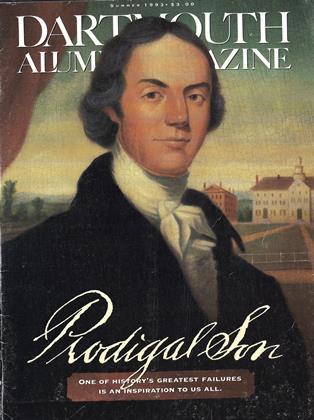IT IS VERY LATE IN the evening during fall term, 1959. I am stretched out on the couch engrossed in For Whom the Bell Tolls, or maybe it's King Lear. Slide rule in hand, Connie, one of my roommates—a math/physics major—is hunched over his desk, working on what seem to me to be impossibly difficult mathematical problems. He turns to me and says, "I learned something interesting today."
"Hmmm?"
"Zero to the zero power equals one."
"Huh?"
"Zero to the zero power equals one."
"Who taught you that?" I growl, peering over the top of my book.
"My math professor."
"That's the craziest thing I ever heard. You can't multiply zero zero times and get one."
"Yes you can."
"Conrad, you can't.
Your professor can't. And I can't. If I could, I wouldn't have to go to work for a living. Whenever I wanted to, I'd pay myself zero dollars, multiply that amount zero times, and get a dollar. This I would do several hundred times a week, buy a fancy car, join a country club, and chase women."
Feeling righteous (and adventurous, thanks to a brew or two, I'm sure), I post Connie's professor, a certain John G. Kemeny, a note telling him that I never heard of such a stupid thing, and that he ought to be ashamed of himself for promulgating such nonsense.
About a week later back comes a letter from Professor Kemeny, inviting me to his office.
Well, in for a dime, in for a dollar, I figure.
"Please sit down," the professor says, showing me into his office. May I offer you some coffee or tea? "Share with me, if you will, the extent of your study of mathematics."
"Well, uh, two years of algebra and a year of plane geometry in high school, and I scraped by Math 1 here last year." (I'm not about to tell him that I never got a firm grip on how to multiply and divide fractions in grade school, either.)
"Very well," he says, without rancor or condescension. "Let me begin."
He turns to the blackboards surrounding us and proceeds to fill them with a blizzard of formulae, numbers, strange-looking symbols, and letters in English and Greek, all the while providing a running commentary, of which I understand, you should pardon the expression, zero.
Finally, after what seems like a half hour of this, he triumphantly tattoos the last available square inch of blackboard space with what I do know as the symbol for "therefore," followed by 0°=1.
Whereupon he turns to me and with a kindly smile says, "Did you understand?"
"Not a word," I mumble, preparing to leave.
He pulls his chair around from behind his desk, places it next to mine and sits down.
"I suspected you wouldn't," Professor Kemeny says gently. "But I wanted to show you that technically the principle is more or less provable with the use of some imaginative and creative higher mathematics. Now then, perhaps, I can give you an explanation which will be easier to grasp."
"No, really, Professor. It's 0K..."
"Bear with me. Did you learn somewhere in your study of math that 12= 1?"
"Yes."
"No problem with that concept?"
Even I know that! "No, no, of course not. 1 times 1 is 1."
"Good. Now then, thinking logically, do you also understand that if we reduce the..." Although I no longer remember how his reasoning went, and am afraid to attempt reconstructing it 30 years later lest my roommate or some other mathematical genius out there catches me misquoting the logic, Professor Kemeny did indeed show me that as the numbers involved get smaller and smaller, the result continues to be 1.
Finally, when the answer is still 1 even though we are down to multiplying infinitesimally small numbers by equally infinitesimally small powers, Professor Kemeny places a hand quite close to one of mine. Our pinky fingers are almost touching.
"Now then, Mr. Oestreicher," he says softly admid the lateafternoon quiet of a now-deserted math department. "We've spent the last few minutes making our numbers smaller and then smaller and then smaller still, approaching—but I will admit, never quite reaching zero itself. I must confess to you that to pursue and explore the course of several branches of higher mathematics it is vital to be able to say and believe that 00=1."
Is there a slight tone of conspiracy in the whisper of his voice?
"It is now time to ask you in joining me and all of my colleagues in mathematics in making what the philosophers call the Inductive Leap. Will you leap with us that tiniest of distances from the infinitesimally Small..."
Professor Kemeny slides his pinky that last tiny fraction of an inch along the wood of the armchair to touch mine.
"...to the absolutely nothing..."
There's magic in the room.
"...and say therefore with certainty that 0 =1?"
Silence. Then...what, me prevent the pursuit of higher mathematics? Not on your life.
I believe. Absolutely, I believe.
And after a nod and a smile and a handshake and a farewell, I float out of his office.
As I say, this 60-minute moment in time occurred more than 30 years ago. I've forgotten the particulars of the mathematics. But I've never forgotten the hour.
Anthony J. Oestericher is an advertising executive in New York.
 View Full Issue
View Full Issue
More From This Issue
-
 Cover Story
Cover StoryThis Man Scanndalized Eleazar Wheelock
June 1993 By Jerold Wikoff -
 Feature
FeatureTHE PEMI AFFAIR
June 1993 By KIRK SIEGEL'82 -
 Feature
FeatureRescuing the Wisdom of Vanishing Tribes
June 1993 By Robert Eshman '82 -
 Feature
FeatureTrip to the sea
June 1993 By Will Lange -
 Feature
FeatureDoes a Bicycle Have a Soul?
June 1993 By Lee Michaelides -
 Article
ArticleDr. Wheelock's Journal
June 1993 By "E. Wheelock"








